Blog & Latest Updates
Fly Fishing Articles
Insects by Common Name


Animal Phylum Arthropoda (Arthropods)
Taxonomic Navigation -?-
Kingdom
Animalia (Animals)
» Phylum Arthropoda (Arthropods)
| Class in Arthropoda | ||
| ArachnidaMites and Spiders | 0 | 1 |
| CollembolaSpringtails | 0 | 0 |
| Crustacea-MalacostracaCrayfish, Scuds, and Sowbugs | 0 | 10 |
| Crustacea-Maxillopoda | 0 | 0 |
| InsectaInsects | 0 | 114 |
Common Name
| Match | Common Name |
| Arthropods |
This is page 10 of specimens of Arthropoda. Visit the main Arthropoda page for:
- The behavior and habitat of Arthropoda.
- 122 underwater pictures of Arthropoda.
Pictures of 1244 Arthropod Specimens:
Siphlonurus quebecensis (Gray Drake) Mayfly Nymph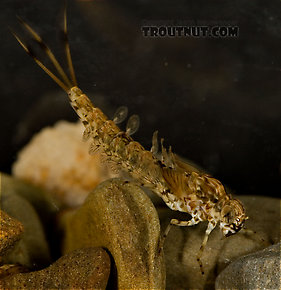 View 9 Pictures
View 9 Pictures
 View 9 Pictures
View 9 PicturesCollected May 13, 2007 from the Delaware River in New York
Added to Troutnut.com by Troutnut on May 18, 2007
Added to Troutnut.com by Troutnut on May 18, 2007
Male Nigronia serricornis (Fishfly) Hellgrammite Adult View 10 Pictures
View 10 Pictures
 View 10 Pictures
View 10 PicturesCollected May 29, 2007 from Brodhead Creek in Pennsylvania
Added to Troutnut.com by Troutnut on June 4, 2007
Added to Troutnut.com by Troutnut on June 4, 2007
Acroneuria abnormis (Golden Stone) Stonefly Nymph View 10 Pictures
View 10 Pictures
 View 10 Pictures
View 10 PicturesCollected May 29, 2007 from Paradise Creek in Pennsylvania
Added to Troutnut.com by Troutnut on June 4, 2007
Added to Troutnut.com by Troutnut on June 4, 2007
Male Baetis (Blue-Winged Olives) Mayfly Dun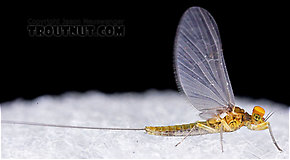 View 14 PicturesThis dun molted most of the way into a spinner (though the wings got stuck) the evening after I photographed it, so I took some more photos of the spinner.
View 14 PicturesThis dun molted most of the way into a spinner (though the wings got stuck) the evening after I photographed it, so I took some more photos of the spinner.
I found a female nearby, probably of the same species.
 View 14 PicturesThis dun molted most of the way into a spinner (though the wings got stuck) the evening after I photographed it, so I took some more photos of the spinner.
View 14 PicturesThis dun molted most of the way into a spinner (though the wings got stuck) the evening after I photographed it, so I took some more photos of the spinner.I found a female nearby, probably of the same species.
Collected September 19, 2006 from Mystery Creek #43 in New York
Added to Troutnut.com by Troutnut on October 4, 2006
Added to Troutnut.com by Troutnut on October 4, 2006
Ranatra Water Scorpion Adult View 7 PicturesHere's a big water scorpion (no relation to actual scorpions). These guys are just about the most sinister-looking creatures you could find, and what's especially creepy is that they can come up out of the water and fly around, as I learned when one left my aquarium and buzzed my head while I was peeking into the microscope at a mayfly nymph.
View 7 PicturesHere's a big water scorpion (no relation to actual scorpions). These guys are just about the most sinister-looking creatures you could find, and what's especially creepy is that they can come up out of the water and fly around, as I learned when one left my aquarium and buzzed my head while I was peeking into the microscope at a mayfly nymph.
 View 7 PicturesHere's a big water scorpion (no relation to actual scorpions). These guys are just about the most sinister-looking creatures you could find, and what's especially creepy is that they can come up out of the water and fly around, as I learned when one left my aquarium and buzzed my head while I was peeking into the microscope at a mayfly nymph.
View 7 PicturesHere's a big water scorpion (no relation to actual scorpions). These guys are just about the most sinister-looking creatures you could find, and what's especially creepy is that they can come up out of the water and fly around, as I learned when one left my aquarium and buzzed my head while I was peeking into the microscope at a mayfly nymph.Collected March 10, 2004 from unknown in Wisconsin
Added to Troutnut.com by Troutnut on January 25, 2006
Added to Troutnut.com by Troutnut on January 25, 2006
Male Cinygmula (Dark Red Quills) Mayfly Spinner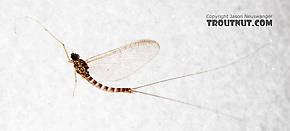 View 11 PicturesI'm unsure of the ID on this one; keys put it closest to Cinygmula reticulata, but I'm very doubtful of the species and not positive on the genus. Epeorus is another possibility, but I don't know which species it would be.
View 11 PicturesI'm unsure of the ID on this one; keys put it closest to Cinygmula reticulata, but I'm very doubtful of the species and not positive on the genus. Epeorus is another possibility, but I don't know which species it would be.
This one was collected in association with a female dun probably of the same species.
 View 11 PicturesI'm unsure of the ID on this one; keys put it closest to Cinygmula reticulata, but I'm very doubtful of the species and not positive on the genus. Epeorus is another possibility, but I don't know which species it would be.
View 11 PicturesI'm unsure of the ID on this one; keys put it closest to Cinygmula reticulata, but I'm very doubtful of the species and not positive on the genus. Epeorus is another possibility, but I don't know which species it would be.This one was collected in association with a female dun probably of the same species.
Collected July 1, 2017 from the South Fork Stillaguamish River in Washington
Added to Troutnut.com by Troutnut on July 2, 2017
Added to Troutnut.com by Troutnut on July 2, 2017
Isonychia bicolor (Mahogany Dun) Mayfly Nymph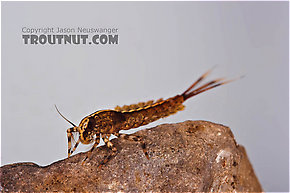 View 7 PicturesThis Isonychia bicolor nymph from the Catskills displays the prominent white stripe sometimes characteristic of its species. This is the first such specimen I've photographed, because members of the same species in the Upper Midwest have a more subdued stripe (and were once thought to be a different species, Isonychia sadleri). The striking coloration on this eastern nymph is more appealing.
View 7 PicturesThis Isonychia bicolor nymph from the Catskills displays the prominent white stripe sometimes characteristic of its species. This is the first such specimen I've photographed, because members of the same species in the Upper Midwest have a more subdued stripe (and were once thought to be a different species, Isonychia sadleri). The striking coloration on this eastern nymph is more appealing.
 View 7 PicturesThis Isonychia bicolor nymph from the Catskills displays the prominent white stripe sometimes characteristic of its species. This is the first such specimen I've photographed, because members of the same species in the Upper Midwest have a more subdued stripe (and were once thought to be a different species, Isonychia sadleri). The striking coloration on this eastern nymph is more appealing.
View 7 PicturesThis Isonychia bicolor nymph from the Catskills displays the prominent white stripe sometimes characteristic of its species. This is the first such specimen I've photographed, because members of the same species in the Upper Midwest have a more subdued stripe (and were once thought to be a different species, Isonychia sadleri). The striking coloration on this eastern nymph is more appealing.Collected April 19, 2006 from the Beaverkill River in New York
Added to Troutnut.com by Troutnut on April 21, 2006
Added to Troutnut.com by Troutnut on April 21, 2006
Maccaffertium ithaca (Light Cahill) Mayfly Nymph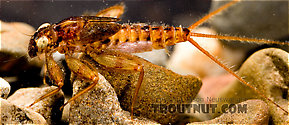 View 9 PicturesThis specimen seems to be of the same species as a dun I photographed which emerged from another nymph in the same sample.
View 9 PicturesThis specimen seems to be of the same species as a dun I photographed which emerged from another nymph in the same sample.
 View 9 PicturesThis specimen seems to be of the same species as a dun I photographed which emerged from another nymph in the same sample.
View 9 PicturesThis specimen seems to be of the same species as a dun I photographed which emerged from another nymph in the same sample.Collected May 29, 2007 from Paradise Creek in Pennsylvania
Added to Troutnut.com by Troutnut on June 4, 2007
Added to Troutnut.com by Troutnut on June 4, 2007
Male Nixe inconspicua Mayfly Dun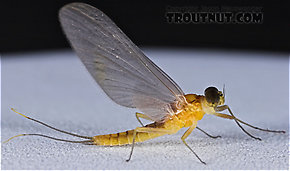 View 13 PicturesThis pretty little dun was part of a sparse midsummer evening hatch on a large Catskill river.
View 13 PicturesThis pretty little dun was part of a sparse midsummer evening hatch on a large Catskill river.
I could not identify it by following a species key step by step, but I tentatively keyed it to the genus Nixe, and based on distribution maps and physical descriptions the most likely species is Nixe inconspicua.
 View 13 PicturesThis pretty little dun was part of a sparse midsummer evening hatch on a large Catskill river.
View 13 PicturesThis pretty little dun was part of a sparse midsummer evening hatch on a large Catskill river.I could not identify it by following a species key step by step, but I tentatively keyed it to the genus Nixe, and based on distribution maps and physical descriptions the most likely species is Nixe inconspicua.
Collected July 13, 2005 from the East Branch of the Delaware River in New York
Added to Troutnut.com by Troutnut on April 14, 2006
Added to Troutnut.com by Troutnut on April 14, 2006
Male Rhithrogena virilis Mayfly Spinner View 12 PicturesI'm fairly sure this is a specimen of Rhithrogena virilis based on closeup examination of the reproductive anatomy under the microscope (not shown in photos). The other other species of Rhithrogena this large is Rhithrogena flavianula, but the key in Needham's Biology of Mayflies mentions annulation in the abdomen (visible in some images on bugguide.net) more distinct than that on this specimen.
View 12 PicturesI'm fairly sure this is a specimen of Rhithrogena virilis based on closeup examination of the reproductive anatomy under the microscope (not shown in photos). The other other species of Rhithrogena this large is Rhithrogena flavianula, but the key in Needham's Biology of Mayflies mentions annulation in the abdomen (visible in some images on bugguide.net) more distinct than that on this specimen.
The body and front wing were both about 15.5 mm long, while the cerci (Cercus: The left and right "tails" of an insect are known as the cerci or caudal cerci. The middle tail of a three-tailed insect is not.) were 40 mm long.
 View 12 PicturesI'm fairly sure this is a specimen of Rhithrogena virilis based on closeup examination of the reproductive anatomy under the microscope (not shown in photos). The other other species of Rhithrogena this large is Rhithrogena flavianula, but the key in Needham's Biology of Mayflies mentions annulation in the abdomen (visible in some images on bugguide.net) more distinct than that on this specimen.
View 12 PicturesI'm fairly sure this is a specimen of Rhithrogena virilis based on closeup examination of the reproductive anatomy under the microscope (not shown in photos). The other other species of Rhithrogena this large is Rhithrogena flavianula, but the key in Needham's Biology of Mayflies mentions annulation in the abdomen (visible in some images on bugguide.net) more distinct than that on this specimen.The body and front wing were both about 15.5 mm long, while the cerci (Cercus: The left and right "tails" of an insect are known as the cerci or caudal cerci. The middle tail of a three-tailed insect is not.) were 40 mm long.
Collected July 5, 2017 from the South Fork Sauk River in Washington
Added to Troutnut.com by Troutnut on July 6, 2017
Added to Troutnut.com by Troutnut on July 6, 2017
Top 10 Fly Hatches
Top Gift Shop Designs
Eat mayflies.
Top Insect Specimens
Miscellaneous Sites
Troutnut.com is copyright © 2004-2024 Jason
Neuswanger (email Jason). See my FAQ for information about use of my images.
 privacy policy
privacy policy
